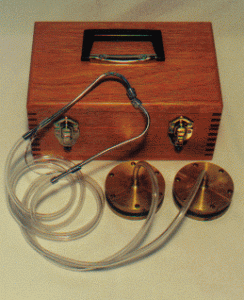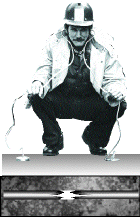Geophone Leak Detection Systyem
 For best results, place the sensing head firmly against the surface being explored. While it does not have to be on a horizontal plane, the instrument works best when it is free standing, since the circulation of blood in the hands will set up detectable vibrations. The instrument performs equally well on soil, ice, hard packed snow, pavement or any solid substance. Light packed snow or grassy surfaces tends to distort or muffle the leak sounds. In these cases it is suggested that you dig down to solid ground or drive a metal rod into the ground, leaving approximately two inches of the rod above the ground. Place the disc on top of the rod and listen. In addition to the rush of water you will some times hear an erratic clicking sound. This is caused by rocks and gravel banging against the pipe in the high pressure stream of leaking water. Remember that the Geophone is designed and built for detection of vibrations in solid substances, not in gaseous media.
For best results, place the sensing head firmly against the surface being explored. While it does not have to be on a horizontal plane, the instrument works best when it is free standing, since the circulation of blood in the hands will set up detectable vibrations. The instrument performs equally well on soil, ice, hard packed snow, pavement or any solid substance. Light packed snow or grassy surfaces tends to distort or muffle the leak sounds. In these cases it is suggested that you dig down to solid ground or drive a metal rod into the ground, leaving approximately two inches of the rod above the ground. Place the disc on top of the rod and listen. In addition to the rush of water you will some times hear an erratic clicking sound. This is caused by rocks and gravel banging against the pipe in the high pressure stream of leaking water. Remember that the Geophone is designed and built for detection of vibrations in solid substances, not in gaseous media.
 Using drawings or pipe locators, first find the exact location of the main. Begin searching in the spot where you most suspect the leak to be. Place the sensing heads on the ground above the main, spaced approximately three feet apart. The sounds you hear may reach one ear sooner than the other. By moving the heads you will reach a spot where the sound is of the same intensity in both sensing heads and reaches both ears at the same time. You are now directly above the leak site.
Using drawings or pipe locators, first find the exact location of the main. Begin searching in the spot where you most suspect the leak to be. Place the sensing heads on the ground above the main, spaced approximately three feet apart. The sounds you hear may reach one ear sooner than the other. By moving the heads you will reach a spot where the sound is of the same intensity in both sensing heads and reaches both ears at the same time. You are now directly above the leak site.
When sound is equalized on both sides you are over the leak

